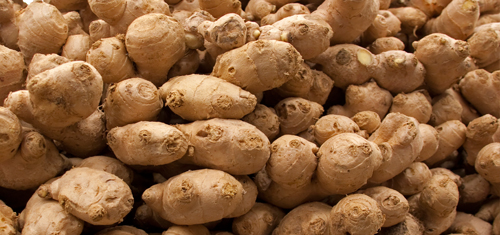Dried Ginger
Dried Ginger
Pronounced: JIN-jur

Ginger has a horny and tubular body which stands on earth with stem support of about 70 cms. The tuber also called rhizome can be used in various forms; Dried, Whole, Fresh, Sweetened, to name a few. The yellow and green flowers emerge among the green leaves in clusters. Grown throughout the year in loess, it is harvested in hot tropics in the presence of ample rainfall.
What Is Dried Ginger?
 Ginger (Zingiber officinale) known as Gingembre in French, Ingwer in German Zanzabil in Arabic & Persian texts and fresh variety as known as Ardhrakam in Sanskrit or Adrakh in common Indian texts, is cultivated on a large scale in the warm moist regions. The dried rhizomes of ginger are known as Shunthi or Maha-oushdham in Sanskrit and Sonth in Hindi texts.
Ginger (Zingiber officinale) known as Gingembre in French, Ingwer in German Zanzabil in Arabic & Persian texts and fresh variety as known as Ardhrakam in Sanskrit or Adrakh in common Indian texts, is cultivated on a large scale in the warm moist regions. The dried rhizomes of ginger are known as Shunthi or Maha-oushdham in Sanskrit and Sonth in Hindi texts.
The fresh rhizomes are soaked in water overnight after which the outer peel is carefully removed using a knife or a peeler. They are washed again and then sun dried on mats or barbecues for around a week. During this period, they are turned periodically. The end result is a pale white dried ginger. Many a times, dried ginger is bleached with calcium carbonate to get a whitish covering on ginger. However, this is not required and can be avoided.
If ginger is unpeeled and then dried, it is called Brown Ginger. As opposed to this, if it is peeled and dried, then it is called White Ginger. Possessing excellent medicinal values, Ginger & Dried Ginger powder have been regarded as a Wonder Cure in all Ayurvedic texts. The scraped and dried rhizomes as well as the green ones are used in many Ayurvedic remedies.
Plant and Cultivation
Ginger grows in warm and humid climate. It is mainly cultivated in the tropics from sea level to an altitude of above 1500 MSL and it can be grown both under rainfed and irrigated conditions. For successful cultivation, ginger requires a moderate rainfall at the sowing time till the rhizomes sprout, fairly heavy and well distributed showers during the growing period and dry weather for about a month before harvesting. Ginger thrives the best in well drained soils like sandy or clay loam, red loam or lateritic loam. A friable loam rich in humus is ideal. However, being an exhaustive crop it may not be desirable to grow ginger in the same site year after year. It thrives well under partial shade, though it is also grown on a large scale in open areas. Ginger can be cultivated organically as an inter or mixed crop provided all the other crops are grown following organic methods. It may be intercropped with shade-giving plants, e.g. banana, pigeon-pea, tree castor and cluster bean (guar). Ginger is grown as a mixed crop, in coconut, young coffee and orange plantations on the west coast at higher altitudes.
Fresh ginger gets its pungency and aroma from the flavour compound gingerol. When ginger is dried gingerol undergoes a dehydration, forming shogaols which are twice as pungent as gingerol. In contrast to its pungency, the aromas remain the same. The way ginger is treated after harvesting and cleansing differs according to the country in which it is grown: for instance, in West Africa the rhizomes are dried without peeling, while in Bengal they are soaked in water overnight and superficially scraped; goods from Malabar or Bombay have the corky rind removed completely and in Jamaica ginger is washed in cold water, carefully peeled and re-soaked. The latter is particularly prized because of its fine aroma.
Description
Ginger is the washed, irregular-shaped rootstock (rhizome) of the reed-like ginger plant of the family Zingiberaceae, which is cultivated in the tropics and grows as tall as 1.5 m. The rootstock shape resembles a human hand (hands or claws). Ginger has a characteristic, bitingly pungent, slightly sweetish and aromatic flavor. If ginger has simply been washed and dried, but not peeled, it is known commercially as “black” or “green” ginger, while the peeled product is known as “white” ginger. With peeled ginger, the outer peel is removed with special knives prior to drying, while with “split” ginger the ginger tuber is split first to speed up the drying process. The rootstock treated in this way is then cut into slices or chunks and often immersed in or dusted with a lime solution to bleach it and protect it against pests However, this process has become less significant with the development of modern fumigation methods. Ginger from the finest shoots of the rootstock is also imported in crystallized form in earthenware jugs and in syrup in wooden kegs, specially from China and the West Indies.
Producing Countries of Dried Ginger
It is produced and cultivated in tropical regions with often sunny climates. Ginger is rarely found in the wild. The major ginger producing countries are India, China, Nigeria, Indonesia, Bangladesh, Thailand, Philippines, Jamaica etc. It is also grown in Australia, Fiji,, Brazil, Sierra Leone and Japan. Nigeria ranks first with respect to area under ginger covering about 56.23 % of the total global area followed by India (23.6%), China (4.47%), Indonesia (3.37%) and Bangladesh (2.32%). India ranks first with respect to ginger production contributing about 32.75% of the world’s production followed by China (21.41%), Nigeria (12.54%) and Bangladesh (10.80%). Asian countries lead in the supply of ginger in the world market.
Consuming Countries of Dried Ginger
United Kingdom, United States, Japan and Saudi Arabia import large quantities of dried ginger. Japan and USA are the major importers of dried ginger.
